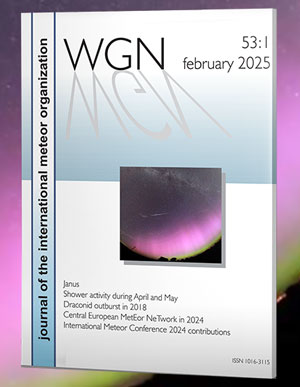During this period the moon reaches its last quarter phase on Tuesday September
20th. At this time the moon will lie ninety degrees west of the sun and will
rise near 0100 local daylight time (LDT) as seen from mid-northern latitudes.
This weekend the waning gibbous moon will interfere with meteor observing during
the morning hours. Skies will be dark during the early evening hours until moon
rise, which will occur during the late evening hours. It would be better to wait
until later this week to view meteor activity, when the moon becomes less
bothersome. The estimated total hourly rates for evening observers this week is
near four as seen from the northern hemisphere and two as seen from the southern
hemisphere. For morning observers the estimated total hourly rates should be
near nine as seen from mid-northern latitudes and six from mid-southern
latitudes. The actual rates will also depend on factors such as personal light
and motion perception, local weather conditions, alertness and experience in
watching meteor activity. Morning rates are reduced due to moonlight.
The radiant (the area of the sky where meteors appear to shoot from) positions
and rates listed below are exact for Saturday night/Sunday morning September
17/18. These positions do not change greatly day to day so the listed
coordinates may be used during this entire period. Most star atlases (available
at science stores and planetariums) will provide maps with grid lines of the
celestial coordinates so that you may find out exactly where these positions are
located in the sky. A planisphere or computer planetarium program is also useful
in showing the sky at any time of night on any date of the year. Activity from
each radiant is best seen when it is positioned highest in the sky, either due
north or south along the meridian, depending on your latitude. It must be
remembered that meteor activity is rarely seen at the radiant position. Rather
they shoot outwards from the radiant so it is best to center your field of view
so that the radiant lies at the edge and not the center. Viewing there will
allow you to easily trace the path of each meteor back to the radiant (if it is
a shower member) or in another direction if it is a sporadic. Meteor activity is
not seen from radiants that are located below the horizon. The positions below
are listed in a west to east manner in order of right ascension (celestial
longitude). The positions listed first are located further west therefore are
accessible earlier in the night while those listed further down the list rise
later in the night.
The following showers are expected to be active this week:
The Southern Taurid (STA) radiant is now centered at 01:08 (017) +05. This area
of the sky lies in southern Pisces, three degrees north of the fourth magnitude
star Epsilon Piscium. This radiant is best placed near 0200 LDT, when it lies on
the meridian and is located highest in the sky. Rates at this time should be
near two per hour no matter your location. With an entry velocity of 27 km/sec.,
the average Southern Taurid meteor would be of medium-slow speed.
Many radiants in the region of Eridanus have been suspected this time of year.
Recent studies of the IMO’s video database by Sirko Molau and Juergen Rendtel
has verified a radiant active in Eridanus from September 3rd through the 24th
with maximum activity occurring on the 7th. The Nu Eridanid (NUE) radiant is
currently located at 04:53 (073) +06. This position lies in western Orion near
the third magnitude star Pi 3 Orionis. The radiant is best placed during the
last hour before the start of morning twilight. Rates may be close to one per
hour this week. With an entry velocity of 68 km/sec., most activity from this
radiant would be swift. With the radiant lying close to the celestial equator,
these meteors are seen equally well from both hemispheres.
As seen from the mid-northern hemisphere (45N) one would expect to see
approximately six sporadic meteors per hour during the last hour before dawn as
seen from rural observing sites. Evening rates would be near three per hour. As
seen from the mid-southern hemisphere (45S), morning rates would be near three
per hour as seen from rural observing sites and one per hour during the evening
hours. Locations between these two extremes would see activity between the
listed figures. Morning rates are reduced by moonlight.
The table below presents a condensed version of the expected activity this week.
Rates and positions are exact for Saturday night/Sunday morning.
| SHOWER | DATE OF MAXIMUM ACTIVITY | CELESTIAL POSITION | ENTRY VELOCITY | CULMINATION | HOURLY RATE | CLASS* |
| RA (RA in Deg.) DEC | Km/Sec | Local Standard Time | North-South | |||
| Southern Taurids (STA) | – | 01:08 (017) +05 | 27 | 0200 | 2 – 2 | II |
| Nu Eridanid (NUE) | Sep 07 | 04:53 (073) +06 | 68 | 0700 | 1 – 1 | IV |




 You saw something bright and fast? Like a huge shooting star? Report it: it may be a fireball.
You saw something bright and fast? Like a huge shooting star? Report it: it may be a fireball.  You counted meteors last night? Share your results with us!
You counted meteors last night? Share your results with us!  You took a photo of a meteor or fireball? You have a screenshot of your cam? Share it with us!
You took a photo of a meteor or fireball? You have a screenshot of your cam? Share it with us!  You caught a meteor or fireball on video? Share your video with us!
You caught a meteor or fireball on video? Share your video with us!